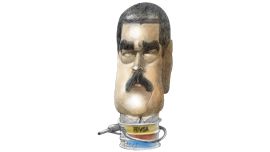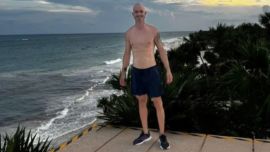A Life of Their Own, which opened last week at the MALBA, is an exceptional exhibition showcasing the work of conceptual art pioneer David Lamelas, whose art has inspired many an artist to break conventions and present reality differently.
The artist, who was part of the Di Tella group in the mid-1960s, was visibly emotional at the exhibition’s recent inauguration. With a soft voice and teary eyes, he thanked contemporaries such as Oscar Bony, Pablo Suárez, Rubén Santantonín (who are sadly no longer with us) for making him who he is today. Lamelas shared stories from his past, joyfully recalling how he auditioned for Marta Minujin, participating in the iconic Menesunda. “I was subjugated to a word game,” he reminisced. “She’d shout out ‘Milas’ to which I responded ‘Fritas.’ She’d said ‘Space’ and I responded ‘Time.’ After this went on back and forth, she called Ruben and I was part of team!”
TIME
Space and time are key elements in David Lamelas’ work. This is clear from the very start of this current retrospective, through a blown-up photo of his performance Time (1970), which, for the occasion, will be re-enacted. On April 4 and 11, at 6.30pm, in the presence of the artist, a line of approximately 20 people will ‘pass on time.’ Each participant will have ‘it’ (the time) for one minute before it is passed on to the next. The last person will then finally read the time out loud. In the text accompanying this performance, he wrote in 1970: “Time is about social issues. We may come from different cultures, be of different colour or religion, but we all share the one single time of the present.”
At this moment Lamelas had already moved to Europe. Aged just 22 years old, he had represented Argentina at the Venice Biennale, where he had left an impression with Office of Information about the Vietnam War at Three Levels: The Visual Image, Text and Audio, an office space with a telex, where the news, directly transmitted from the warzone, was read out loud, a comment on the nature of time and space in a changing information society. This sparked his career and he moved from Buenos Aires to study at Saint Martin’s School of Art in London, where he studied with sculptor Anthony Caro, who had an open mind toward how his students – including Gilbert and George, Richard Long and Barry Flanagan, aside from Lamelas – regarded sculpture.
SPACE
For Lamelas, sculpture is about space and not the material or monumentality of sculpture. “And space is not empty, it has a volume,” he says. Lamelas is interested in how we use and appreciate space. On the doorsteps of the MALBA, we see two beach chairs and a palm tree encircled by white panels on the floor. This is a new version of Signaling of Three Objects (1968), a work he made in Hyde Park, where he encircled a chair, a tree and a lamppost, showing that real life already brings forth ‘ready-made’ art, which we could consider as sculptures in and of themselves. A photo of the earlier work is displayed in the hall near the entrance to the café inside MALBA, for your comparative curiosity.
Like Signaling, more of Lamela’s more historic pieces have received a life of their own. Connection of Three Spaces, first shown at the Di Tella Institute in 1966, is another example. This is a work that cannot be seen in one glance. As a visitor you have to move around to see the entirety of it, which you can only form as such in your mind. The three different elements which compose the sculptural installation are placed in different spaces within the gallery or museum: installation-art ‘avant la letter.’
PIONEER
And he was a pioneer with more of his ideas-turned-art objects. Kristina Newhouse, the US curator of the show – which was co-organised with the University Art Museum of the California State University, Long Beach, as part of Pacific Standard Time LA/LA – heralds Lamelas for being a front-runner on many levels. For example, she points to his photo series Rock Star (Character Appropriation) from 1974, in which the artist is portrayed in different poses that are characteristic of rock stars, appropriating the stature of this symbol “long before someone like Cindy Sherman did this, who has become known for character appropriation.” Newhouse shared how when she first proposed this exhibition – which she curated with Argentine María José Herrera – to the Getty Institute as part of LA/LA, its value was instantly recognized. She considers the recognition well deserved: “The first solo show of Lamelas in a US museum!”
For MALBA, it’s the second time the institution has hosted a major overview of David Lamelas. Twelve years later, the artist is once again overwhelmed. So much so in fact that he has decided to donate a work to the museum: Time as Activity, Buenos Aires 2010. This work is a triptych of photos of and within Argentina’s Congress, and a 16mm film of the Congress in session – within a limited amount of time. “They were talking about something important,” he recalls, “about same-sex marriage, yes!” The Time as Activity series started in 1969, showing certain moments of time – which in the end is a human invention – from the city of Düsseldorf. Even though the results in his Time as Activity series are photos or film, the medium he uses is time itself, questioning our timed reality.
STYLE
Using the camera, and being fascinated by the technological means of mass media, it didn’t take Lamelas long to begin working with film, especially after he moved to Los Angeles. “For three weeks I just watched films and television to get myself immersed in the Hollywood style,” he says. Together with Hildegarde Duane, the duo made their own fictitious realities or staged documentaries, which are also available to view in the current exhibition, and as part of MALBA’s film programme.
One of the most remarkable examples is The Dictator (1976), in which Lamelas plays a Latin America dictator being questioned by Duane, as if part of a news television interview, on disappearances during his regime, the death of his wives and his intention of returning to his country. Lamelas does not consider himself to be a political artist though. As he has said in many interviews: we are part of our present reality and we respond to it. For Lamelas it comes down to the sharing of space and time. How do we see it? And what we do with it?
His objects have a life of their own now, to be pondered over at the MALBA until June 11.
David Lamelas: A Life of Their Own.
MALBA, Avenida Figueroa Alcorta 3415.
Open Thursday to Monday from 12pm-8pm, Wednesdays from 12pm-9pm, until June 11.
Entrance: 120 pesos.

























Comments